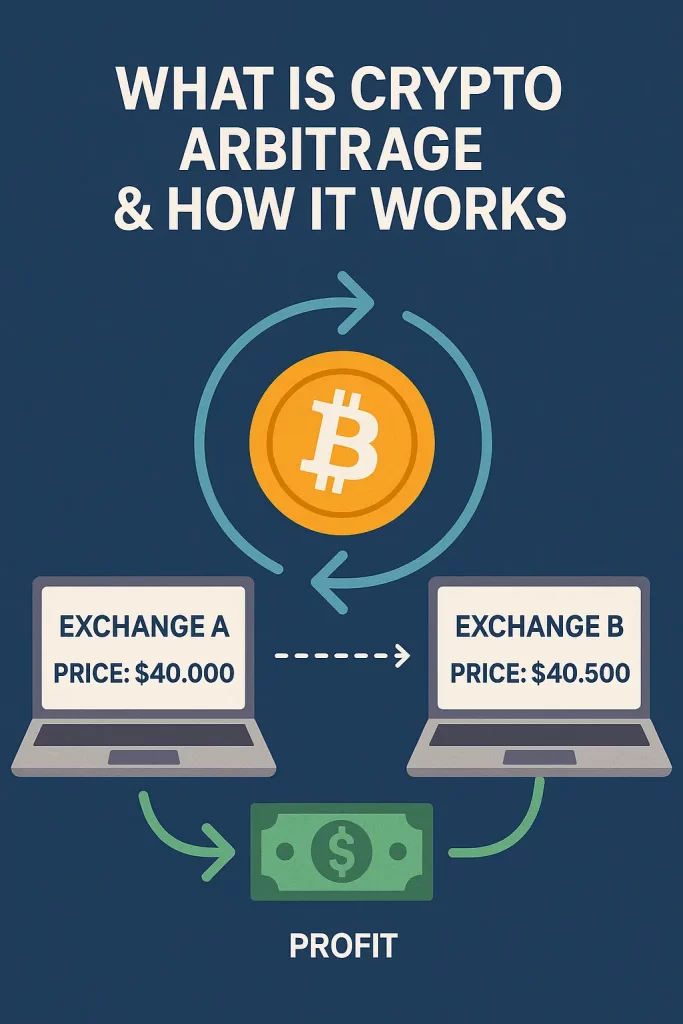What Is Crypto Arbitrage? How It Works & How to Profit?
Crypto arbitrage offers a compelling way to profit from price disparities in the cryptocurrency market, but it demands quick thinking and careful planning. By exploiting price gaps across exchanges, you can earn profits with relatively low risk compared to other trading strategies. In this guide, you’ll discover how crypto arbitrage works, the types of strategies available, the risks involved, best practices, and a practical example to clarify the process.

Introduction to Crypto Arbitrage
Crypto arbitrage involves purchasing a cryptocurrency, like Bitcoin or Ethereum, on one exchange where it’s priced lower and selling it on another where it’s higher, capturing the price delta as profit. This strategy, rooted in traditional financial markets, thrives in the decentralized crypto ecosystem, where market inefficiencies create frequent price variations due to differing supply, demand, and trading volumes across global exchanges.
For instance, Bitcoin might trade at $50,000 on Binance but $50,200 on Coinbase, offering a potential profit of $200 per Bitcoin after costs. The appeal lies in its low-risk nature, as you’re trading the same asset without betting on long-term price movements. However, challenges like fees and timing require careful management, as we’ll explore.
Why It’s Appealing: Crypto arbitrage attracts traders because it leverages market inefficiencies, allowing you to profit consistently with the right tools and strategies, making it ideal for both novices and experienced investors.
How Crypto Arbitrage Works
To perform crypto arbitrage, you identify and act on price gaps across exchanges. Here’s the process:
- Track Prices: Use platforms like CoinMarketCap or CryptoCompare to monitor real-time prices of cryptocurrencies like Bitcoin or Litecoin across exchanges such as Binance or Kraken. These tools highlight disparities, such as Ethereum at $2,000 on one exchange and $2,050 on another.
- Evaluate Profitability: Ensure the price gap exceeds costs, including trading and withdrawal fees. A $50 spread might yield profit if fees are low.
- Execute Trades: Purchase the cryptocurrency on the lower-priced exchange and liquidate it on the higher-priced one. Rapid execution is essential, as spreads can close within seconds due to market activity.
- Manage Transfers: Transferring funds between exchanges can introduce delays due to blockchain confirmations, increasing the risk of price shifts. Many traders maintain accounts on multiple platforms to avoid this.
For example, if Ripple (XRP) is $1.00 on Huobi and $1.05 on Bitstamp, you could buy 1,000 XRP for $1,000 and sell for $1,050, aiming for a $50 profit after fees. Timely trade execution is key, as delays can erode gains. Tools and automation.
Types of Crypto Arbitrage
You can explore several arbitrage strategies, each with distinct approaches:
- Spatial Arbitrage: Capitalize on price disparities across exchanges. For example, buy Litecoin on Kraken for $150 and sell on Bitstamp for $155, profiting from the $5 gap after costs.
- Triangular Arbitrage: Trade three cryptocurrencies in a loop within one exchange or across platforms. For instance, convert BTC to ETH, ETH to XRP, and XRP back to BTC, exploiting exchange rate inefficiencies to gain more BTC.
- Statistical Arbitrage: Use advanced statistical models to identify mispriced assets based on historical data. This complex strategy suits traders with quantitative expertise and sophisticated tools.
Spatial arbitrage is beginner-friendly, while triangular and statistical arbitrage require more skill. Each leverages market inefficiencies differently, offering varied profit potential.
Risks of Crypto Arbitrage
Crypto arbitrage isn’t risk-free. Here are the key challenges:
- Transaction Fees: Every trade incurs costs, including:
- Trading Fees: Typically 0.1–0.2% per trade (e.g., $2 on a $2,000 trade).
- Withdrawal Fees: Fixed or variable fees for transferring crypto (e.g., 0.0005 BTC, or $25 at $50,000/BTC).
- Deposit Fees: Some exchanges charge for incoming funds. These fees can significantly reduce profits, especially on small price gaps.
- Slippage: Due to market volatility, the executed price may differ from the expected one, reducing or eliminating profits. For example, a $50 gap might shrink to $20 during execution.
- Execution Delays: Blockchain transfers can take minutes, allowing prices to shift. Network congestion exacerbates this.
- Liquidity Risks: Low liquidity on smaller exchanges can prevent large trades at desired prices, moving the market against you.
- Regulatory Risks: Regulations vary globally. Some regions impose KYC requirements or restrict cross-border transfers, limiting access to certain exchanges. Tax implications, like capital gains reporting, also apply.
Best Practices for Crypto Arbitrage
Maximize your success with these tips:
- Select Reliable Exchanges: Use trusted platforms for high liquidity and security. Low-fee exchanges boost profitability.
- Stay Informed: Monitor market news to anticipate volatility that could create or disrupt opportunities.
- Start Small: Begin with modest trades to learn the process and minimize losses while gaining experience.
- Diversify Strategies: Combine spatial and triangular arbitrage to adapt to market conditions, increasing your profit potential.
- Leverage Automation: Use trading bots to execute trades swiftly, as manual trading is often too slow.
How to Spot Arbitrage Opportunities
Identifying arbitrage opportunities requires the right tools and strategies:
- Price Aggregation Tools: Platform like CryptoCompare provide real-time price data across exchanges, highlighting gaps for assets like Ethereum or Ripple.
- Price Alerts: Set alerts on trading platforms or bots for specific price conditions, such as Bitcoin being 1% cheaper on Binance than Coinbase.
- Exchange APIs: Integrate APIs from exchanges like Binance into custom scripts for live price feeds, enabling automated monitoring.
- Market Trend Analysis: Study market trends to anticipate price disparities. High volatility, often driven by news or events, can widen spreads, though it increases risks.
- Trading Bots: Automate opportunity detection with bots that scan multiple exchanges and execute trades when profitable gaps appear.
Example of Crypto Arbitrage
Let’s examine a concise arbitrage trade. Suppose Bitcoin trades at $50,000 on Binance and $50,200 on Coinbase, a $200 gap. You decide to trade 1 BTC:
| Item | Amount |
|---|---|
| Buy Price (Binance) | $50,000 |
| Trading Fee (0.1%) | $50 |
| Total Buy Cost | $50,050 |
| Sell Price (Coinbase) | $50,200 |
| Trading Fee (0.1%) | $50.20 |
| Total Sell Revenue | $50,149.80 |
| Withdrawal Fee (0.0005 BTC) | $25 |
| Net Profit | $124.80 |
You purchase 1 BTC on Binance for $50,050 (including fees) and sell on Coinbase for $50,149.80 (after fees). After a $25 withdrawal fee, your profit is $124.80. Volatility or delays could reduce this, but automation can minimize risks.

